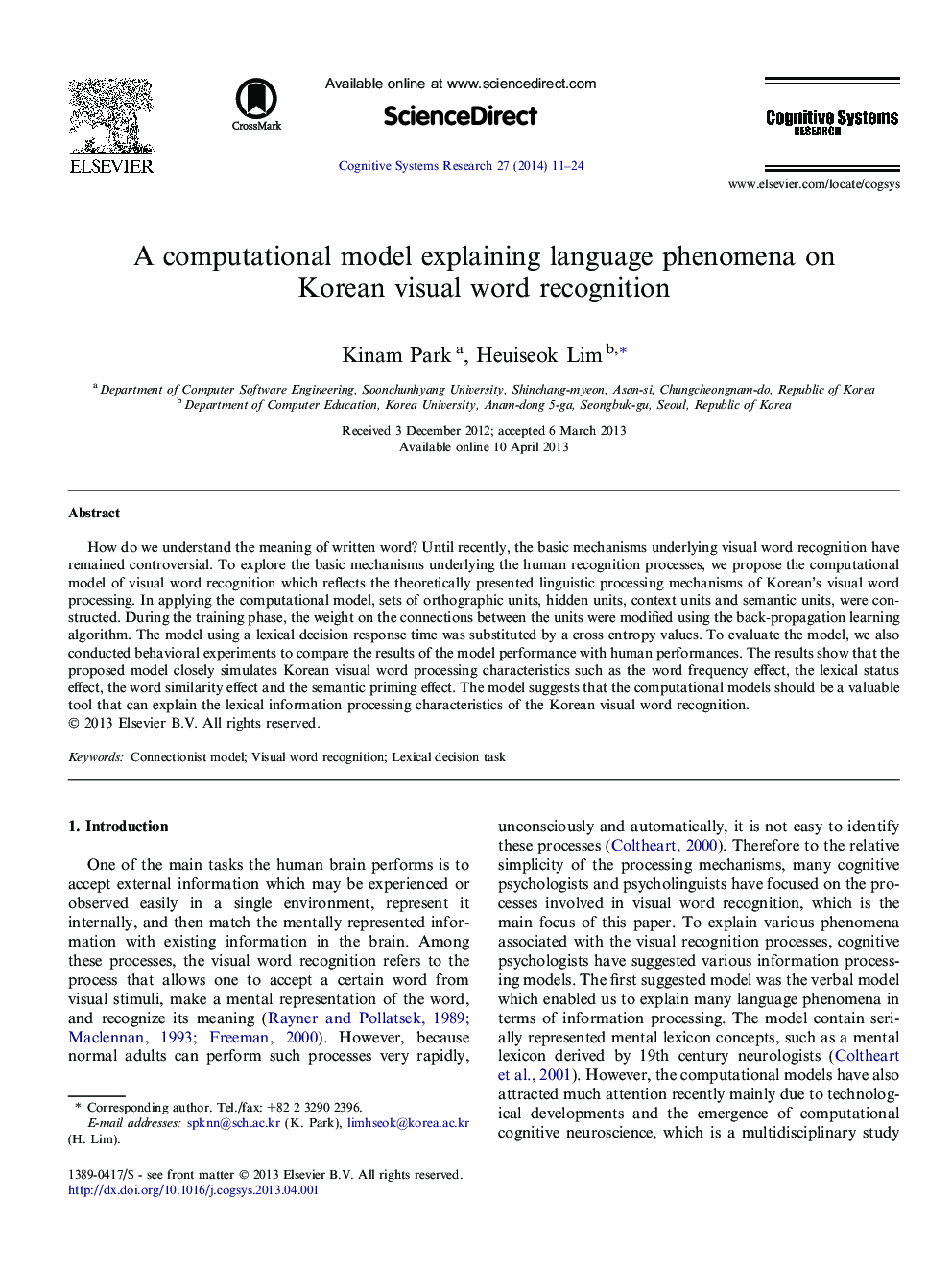| کد مقاله | کد نشریه | سال انتشار | مقاله انگلیسی | نسخه تمام متن |
|---|---|---|---|---|
| 6853866 | 659146 | 2014 | 14 صفحه PDF | دانلود رایگان |
عنوان انگلیسی مقاله ISI
A computational model explaining language phenomena on Korean visual word recognition
ترجمه فارسی عنوان
یک مدل محاسباتی که پدیده های زبان را در شناخت کلمه بصری کره ای توضیح می دهد
دانلود مقاله + سفارش ترجمه
دانلود مقاله ISI انگلیسی
رایگان برای ایرانیان
کلمات کلیدی
مدل اتصالیست شناسایی واژگان بصری، کار تصمیم گیری لکسی
ترجمه چکیده
چطور می توانیم معنای کلمه نوشته شده را درک کنیم؟ تا همین اواخر، سازوکارهای اساسی تشخیص کلمه بصری باقی مانده است. برای کشف مکانیزم های اساسی فرآیندهای شناسایی انسانی، ما مدل محاسباتی را برای تشخیص کلمه بصری ارائه می دهیم که نشان دهنده مکانیسم پردازش زبان شناختی ارائه شده از پردازش متن بصری کره ای است. در استفاده از مدل محاسباتی، مجموعه ای از واحدهای ارتوپدی، واحدهای پنهان، واحدها و واحدهای معنایی ساخته شد. در طول دوره آموزش، وزن بر روی ارتباط بین واحدها با استفاده از الگوریتم یادگیری عقب تغییر یافت. مدل با استفاده از زمان پاسخ تصمیم واژگونه با مقادیر آنتروپی متقابل جایگزین شد. برای ارزیابی مدل، ما همچنین آزمایشهای رفتاری انجام دادیم تا نتایج عملکرد مدل با عملکرد انسان مقایسه شود. نتایج نشان می دهد که مدل پیشنهادی به طور شبیه سازی ویژگی های پردازش کلمه بصری کره ای مانند اثر فرکانس کلمه، اثر وضعیت واژگانی، اثر شباهت کلمه و اثر اولیه معنایی است. این مدل نشان می دهد که مدل های محاسباتی باید یک ابزار ارزشمند باشند که می تواند ویژگی های پردازش اطلاعات لغوی شناخت کلام را درک کند.
موضوعات مرتبط
مهندسی و علوم پایه
مهندسی کامپیوتر
هوش مصنوعی
چکیده انگلیسی
How do we understand the meaning of written word? Until recently, the basic mechanisms underlying visual word recognition have remained controversial. To explore the basic mechanisms underlying the human recognition processes, we propose the computational model of visual word recognition which reflects the theoretically presented linguistic processing mechanisms of Korean's visual word processing. In applying the computational model, sets of orthographic units, hidden units, context units and semantic units, were constructed. During the training phase, the weight on the connections between the units were modified using the back-propagation learning algorithm. The model using a lexical decision response time was substituted by a cross entropy values. To evaluate the model, we also conducted behavioral experiments to compare the results of the model performance with human performances. The results show that the proposed model closely simulates Korean visual word processing characteristics such as the word frequency effect, the lexical status effect, the word similarity effect and the semantic priming effect. The model suggests that the computational models should be a valuable tool that can explain the lexical information processing characteristics of the Korean visual word recognition.
ناشر
Database: Elsevier - ScienceDirect (ساینس دایرکت)
Journal: Cognitive Systems Research - Volume 27, March 2014, Pages 11-24
Journal: Cognitive Systems Research - Volume 27, March 2014, Pages 11-24
نویسندگان
Kinam Park, Heuiseok Lim,
